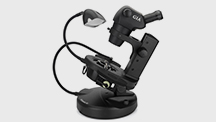Coated Beryl Imitating Emerald
Two major issues related to emerald are origin determination and the presence and quantity of fillers. An emerald’s value depends in part on the quality of the stone and treatments applied, so examination with a gemological microscope is an essential part of any analysis.
A pair of earrings (figure 1, left) weighing a total of 84.06 grams was submitted to the Lai Tai-An Gem Lab for identification. The earrings consisted of numerous green drilled briolettes with a vitreous luster. The client, who claimed they were natural emeralds, granted permission to remove one piece to aid in identification. Testing gave a spot refractive index of 1.57, a specific gravity of 2.67, and an inert reaction to both short-wave and long-wave UV, consistent with beryl. Microscopic observation revealed liquid, crystal, and two-phase inclusions (figure 1, right). Infrared and Raman spectroscopy indicated that the loose stone, along with the similar stones still in the earrings, were beryl. Epoxy peaks at 3056, 3037, 2964, 2931, and 2872 cm–1 were obtained by FTIR spectroscopy (figure 2). However, the green color was unusual in that it appeared to be concentrated on the surface, which was confirmed by additional testing.

Magnification with diffused illumination clearly showed concentrated patches of green color with “colorless” boundaries (figure 3, left), as often seen in diffusion-treated stones such as corundum. Further observation by scanning electron microscopy (SEM) indicated a coating on the faceted surface (figure 3, right). DiamondView imaging revealed the fluorescence reaction of the underlying host beryl where the coating had been worn away at the facet junctions: When exposed to the ultra-short-wave UV of the DiamondView, the “colorless” areas reacted with a strong orange fluorescence (figure 4). UV-Vis-NIR spectra revealed differences between the test stone and a reference emerald. While emerald normally exhibits Cr3+-associated main absorption bands at approximately 620 and 430 nm, the examined samples showed strong absorption bands at approximately 680 and 360 nm, as well as weaker bands at 620 and 430 nm (figure 5)

exhibits significant Cr3+-associated main absorption bands at approximately 620 and
430 nm only (red trace), and the examined sample, which contains absorption bands at
approximately 680 and 360 nm in addition to the 620 and 430 nm bands (green trace).
Coatings have been applied to various gemstones for decades, and most of the time they are easy to identify. Although this identification was not particularly challenging, it does show the importance of thoroughly examining jewelry in case treated stones have been incorporated into the design.



